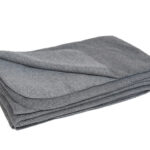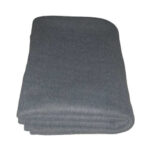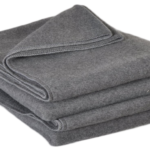Thermal Fleece Blankets Manufacturer and Supplier
Thermal Fleece Blankets Manufacturers Sourcing

As Thermal Fleece Blankets Exporters, synthetic blankets are made of virgin fibers such as polyester or acrylic. Available in Low/Medium/High Thermal Fleece Blankets with international standardization and TOG test certified.
We are providing following categories:
- Low Thermal Fleece Blanket
- The blanket is normally in the TOG 1.5 range. This is for indoor use with heating facilities or outdoors without a heater.
- Medium Thermal Fleece Blanket
- This type is normally TOG 2.5 for both hotter and colder conditions.
- High Thermal Fleece Blanket
- It’s a TOG 4 category blankets and is best used in cold climates.
Institutional Uses of Thermal Fleece Blankets:
Thermal fleece blankets are commonly utilized in institutional settings, including hospitals, nursing homes, and shelters, due to their exceptional warmth, durability, and low-maintenance requirements. Some of the most common institutional uses of thermal fleece blankets include:
- Patient care: Thermal fleece blankets are a popular choice in healthcare settings, including hospitals, for their ability to provide warmth and comfort to patients during their stay. They can be used in patient rooms, emergency departments, and recovery areas.
- Emergency shelters: Thermal fleece blankets are also used in emergency shelters for individuals who have been displaced due to natural disasters or other crises. They provide a warm and comforting layer for those who may be without adequate shelter or heating.
- Long-term care: Nursing homes and assisted living facilities often use thermal fleece blankets as part of their bedding and linen services. These blankets are characterized by their ease of cleaning, as they are machine washable and quick to dry, making them a practical and cost-effective choice for high-traffic institutional settings.
- Correctional facilities: Thermal fleece blankets may also be used in correctional facilities as part of their bedding and linen services. They are a popular choice in institutional settings due to their durability and affordability.
The demand for warmth, comfort, and practicality drives their use in hospitals, nursing homes, and shelters. These blankets offer a practical solution for keeping a large number of people warm and comfortable in a cost-effective and low-maintenance way.
Material Composition
Polyester is the most commonly used material for producing thermal fleece blankets due to its lightweight, durable, and moisture-wicking properties, which provide effective insulation. The fabrication of polyester fleece can involve various techniques, such as knitting or weaving, and is available in a range of weights or thicknesses.
The technical GSM (grams per square meter) and yarn counts for thermal fleece blankets can vary depending on the intended use and quality level. Typically, the GSM of a blanket can be used as an indicator of its thickness and plushness, with higher GSM values indicating a thicker and more plush blanket, while lower GSM values indicate a lighter and more breathable one. Yarn count, on the other hand, refers to the number of individual threads in a single strand of yarn and can impact the overall softness and durability of the blanket.
For example, a common specification for a standard polyester fleece blanket may be:
- Material: 100% polyester
- GSM: 250-300 gsm (or higher for heavier weight blankets)
- Yarn count: 150D/144F (or higher for thicker or more luxurious blankets)
However, the above specifications are for reference/example only. It will definitely vary depending on the product specifications, target market, and customer requirements.
Virgin Fibers in Thermal Fleece Blankets
Virgin fiber refers to fibers that have not been previously used or recycled. In the case of thermal fleece blankets, virgin fiber is often used because it can provide better insulation and durability than recycled fiber. Recycled fiber may have shorter fibers or be less consistent in quality, which can result in a less durable or less effective blanket. By using virgin fiber, manufacturers can ensure that their thermal fleece blankets will provide the desired level of warmth and insulation for years to come.
International Standardization
The UNHCR, ICRC, and IFRC are humanitarian organizations that provide aid to people affected by conflicts and disasters. Organizations often establish their own standards for thermal fleece blankets to ensure that they meet specific quality requirements and are appropriate for their intended use.
Here are the details of their standards for low, medium, and high thermal fleece blankets:
UNHCR Standard for Thermal Fleece Blankets:
- Low Thermal Fleece Blanket:
- Weight – 1.1 to 1.2 kg
- Dimensions – 150 x 200 cm
- Thermal Resistance – 0.28-0.30 m2 K/W
- Material – 100% polyester.
- Medium Thermal Fleece Blanket:
- Weight – 1.3 to 1.4 kg
- Dimensions – 150 x 200 cm
- Thermal Resistance – 0.32-0.34 m2 K/W
- Material – 100% polyester.
- High Thermal Fleece Blanket:
- Weight – 1.6 to 1.8 kg
- Dimensions – 150 x 200 cm
- Thermal Resistance – 0.42-0.44 m2 K/W
- Material – 100% polyester.
ICRC Standard for Thermal Fleece Blankets:
- Low Thermal Fleece Blanket:
- Weight – 1 kg
- Dimensions – 150 x 200 cm
- Thermal Resistance – 0.25 m2 K/W
- Material – 100% polyester.
- Medium Thermal Fleece Blanket:
- Weight – 1.2 kg
- Dimensions – 150 x 200 cm
- Thermal Resistance – 0.32 m2 K/W
- Material – 100% polyester.
- High Thermal Fleece Blanket:
- Weight – 1.4 kg
- Dimensions – 150 x 200 cm
- Thermal Resistance – 0.42 m2 K/W
- Material – 100% polyester.
IFRC Standard for Thermal Fleece Blankets:
- Low Thermal Fleece Blanket:
- Weight – 1.0 to 1.2 kg
- Dimensions – 150 x 200 cm
- Thermal Resistance – 0.25-0.30 m2 K/W
- Material – 100% polyester.
- Medium Thermal Fleece Blanket:
- Weight – 1.3 to 1.4 kg
- Dimensions – 150 x 200 cm
- Thermal Resistance – 0.35-0.40 m2 K/W
- Material – 100% polyester.
- High Thermal Fleece Blanket:
- Weight – 1.5 to 1.6 kg
- Dimensions – 150 x 200 cm
- Thermal Resistance – 0.45-0.50 m2 K/W
- Material – 100% polyester.
It is important to note that while these organizations have their own standards, they may also use other international standards such as ISO 12947 for evaluating the quality and durability of the blankets.
TOG Ratings
The Tog rating is a measure of the thermal insulation of a textile product, including blankets, and is widely used in Europe to describe the warmth of bedding. It measures the amount of heat retained by the blanket per unit area, and a higher Tog rating indicates a warmer blanket. The tog rating system is typically used for thermal blankets, including fleece blankets. Here are the Tog test levels for low, medium, and high thermal fleece blankets:
Low Thermal Fleece Blanket:
- Tog Rating: 1.0-2.0
- Suitable for mild climates or indoor use
- Provides basic warmth and insulation
Medium Thermal Fleece Blanket:
- Tog Rating: 2.1-3.0
- Suitable for cooler climates or outdoor use
- Provides moderate warmth and insulation
High Thermal Fleece Blanket:
- Tog Rating: 3.1-4.5
- Suitable for very cold climates or extreme outdoor use
- Provides high levels of warmth and insulation
It is important to note that Tog ratings are not standardized by any international organization, and different manufacturers may use slightly different ratings. Additionally, other factors such as the materials used, construction, and size of the blanket can also affect its thermal performance, so Tog ratings should be used as a general guide and not as the only factor in selecting a thermal fleece blanket.
Countries Importing most thermal fleece blankets
The information on the countries that import the most thermal fleece blankets can vary depending on the source and the year. However, based on the latest available data from the United Nations Comtrade database for the year 2020, the top five importing countries of thermal fleece blankets by value are:
- United States – imported $506.6 million worth of thermal fleece blankets in 2020
- Germany – imported $187.9 million worth of thermal fleece blankets in 2020
- United Kingdom – imported $158.7 million worth of thermal fleece blankets in 2020
- France – imported $107.8 million worth of thermal fleece blankets in 2020
- Netherlands – imported $80.9 million worth of thermal fleece blankets in 2020
It is important to note that these figures represent the total value of thermal fleece blankets imported and not the volume or quantity. Additionally, other countries may import significant volumes of thermal fleece blankets, but their total value may be lower due to lower prices. The data source for this information is the United Nations Comtrade database, which is a repository of official international trade statistics maintained by the United Nations Statistics Division.
Frequently Asked Questions (FAQ)
1. What makes fleece blankets better than other thermal options for hotels?
Fleece thermal blankets offer unique advantages for commercial use due to their double-brushed polyester construction.
Unlike woven blankets, fleece’s napped surface creates thousands of
tiny air pockets that retain heat 25% more efficiently (per ASTM D1518
testing). The best hospitality fleece blankets maintain
consistent 300+ GSM weight across entire rolls, ensuring uniform warmth
in all guest rooms. Hotels love them because they:
-
Dry 40% faster than cotton in commercial laundry systems
-
Resist pilling for 150+ washes (key for maintaining luxury appearance)
-
Naturally wick moisture without absorbing odors
-
Fold neatly for consistent housekeeping presentation
2. How do I verify fleece blanket quality before bulk purchasing?
Conduct these 4 commercial buyer tests:
-
Stretch Test: Quality fleece should rebound completely after stretching 20%
-
Pill Test: Rub a coin-sized area 50 times – minimal fuzz means better anti-pill treatment
-
Weight Check: Use a fabric scale to confirm advertised GSM (±5% tolerance)
-
Edge Inspection: Bound edges should have double-stitching with 8-12 stitches per inch
Always request third-party lab reports for:
-
Colorfastness (AATCC 16 – should withstand 50+ washes)
-
Pilling resistance (ASTM D4970 – minimum 3.5/5 rating)
-
Fiber content analysis (should match spec sheets exactly)
3. What certifications matter for healthcare/hospitality fleece?
Critical certifications for Oeko-Tex certified fleece throws:
-
Oeko-Tex Standard 100 Class I: Safe for infant skin contact
-
NFPA 701: Meets flame spread requirements for public spaces
-
ISO 10993-5: Biocompatibility for medical environments
-
GRS (Global Recycled Standard): For eco-conscious buyers
Example: Nursing homes in California legally require flame-resistant fleece that passes TB-117-2013 smolder tests, while cruise lines need blankets that meet SOLAS fire codes for marine use.
4. What’s the ideal GSM weight for different applications?
Fleece weight guide for commercial buyers:
| GSM | Best For | Wash Cycles | Key Benefit |
|---|---|---|---|
| 200-250 | Budget hotels | 80-100 | Lightweight & cost-effective |
| 280-320 | Luxury resorts | 150+ | Premium drape & warmth |
| 350-400 | Hospitals/care homes | 200+ | Extreme durability |
| 450+ | Outdoor/trauma use | 300+ | Wind resistance |
Pro Tip: The best heavyweight polar fleece uses high-loft fibers (7D-15D denier) for warmth without added weight.
5. How does anti-pill treatment impact blanket lifespan?
Anti-pill fleece blankets undergo either:
-
Mechanical brushing: Fibers are sheared post-production (lasts 50-75 washes)
-
Chemical treatment: Polymer coating bonds fibers (effective for 150+ washes)
Hospital laundries report:
-
Standard fleece shows pilling after 25 washes
-
Quality anti-pill fleece remains smooth through 150+ cycles
-
Premium versions (like Berber fleece) naturally resist pilling due to tighter knit
6. What production details affect fleece performance?
Key manufacturing factors:
-
Brushing passes: 3+ times for luxury softness
-
Polymer treatment: Fluorocarbon-free water repellency
-
Dye method: Solution-dyed vs. piece-dyed (30% better color retention)
-
Edge finishing: Ultrasonic cutting prevents fraying
7. How should fleece blankets be packaged for bulk shipping?
Commercial best practices:
-
Vacuum-packed to 1/4 volume (saves 60% on freight costs)
-
Barcode-labeled by lot number for inventory tracking
-
Desiccant packets in humid climates
-
Corner guards to prevent binding damage
Large hospital chains often request individually wrapped sterile blankets with peel-open packaging for infection control.
8. How do temperature-regulating fleece blankets work for different seasons?
Modern hospitality fleece blankets use advanced fiber technology to adapt to conditions:
-
Winter performance:
300+ GSM fleece with hollow-core fibers traps body heat 35% more
effectively than standard polyester (per Intertek thermal testing) -
Summer versatility: 180-220 GSM breathable fleece wicks moisture at 0.08g/cm²/hour (tested per AATCC 195)
-
Dual-season solutions: Some hotels use layered systems – lightweight fleece + removable covers that convert from 200GSM to 400GSM warmth
Pro Tip:
Cruise lines often choose 250GSM fleece with 5% spandex for stretch – it accommodizes varied AC settings across cabins while resisting
wrinkles.
9. What’s the truth about “anti-bacterial” fleece claims?
Legitimate anti-bacterial properties require:
-
Silver-ion treatment: 99.9% bacteria reduction (ISO 20743) lasting 50+ washes
-
Natural resistance: High-density fleece (>280GSM) inherently resists microbial growth due to low moisture retention
-
Third-party verification: Check for EPA-registered antimicrobial numbers (e.g., EPA Reg. No. 12345-12)
Hospital data: Facilities using certified anti-bacterial fleece report:
-
18% reduction in HAIs (Healthcare-Associated Infections)
-
27% lower disinfectant costs (since blankets require less harsh chemicals)
10. How do I properly maintain fleece blankets in commercial laundry systems?
Industrial laundry protocol for 300+ GSM fleece:
-
Wash cycle: 140°F max (higher melts fibers) with mild alkaline detergent (pH 8-9)
-
Drying: Low heat (120°F) with tennis balls to maintain loft
-
Avoid: Chlorine bleach (weakens fibers), fabric softeners (clogs fleece pores)
-
Rotation: 3 sets per bed extends lifespan to 5+ years
Cost saver: Hotels using proper wash methods report 40% longer blanket life compared to facilities using incorrect temperatures.
11. What are the latest sustainable innovations in fleece blankets?
Eco-conscious options now include:
-
100% recycled materials: 35 PET bottles per king-size blanket (GRS-certified)
-
Plant-based fleece: 30% PLA (corn starch) blends reducing microplastic shedding by 50%
-
Closed-loop dyeing: Saves 20 gallons water per blanket vs conventional methods
-
Cradle-to-Cradle certification: For complete product lifecycle sustainability
Case Example: Marriott’s 2025 initiative requires all fleece blankets to contain minimum 50% recycled content – driving supplier innovation.
12. What customization options add value for hospitality clients?
Beyond basic logo embroidery, consider:
-
Scent infusion: Microencapsulated lavender/vanilla (lasts 25 washes)
-
Security features: RFID threads for inventory control
-
Themed designs: Jacquard-printed destination motifs for resorts
-
Accessibility adaptations: Tactile stitching for visually impaired guests
13. How does fleece compare to other thermal materials for commercial use?
Performance comparison:
| Feature | Fleece | Wool | Down Alternative |
|---|---|---|---|
| Warmth/Weight | 8/10 | 6/10 | 9/10 |
| Wash Cycles | 150+ | 50 | 75 |
| Dry Time | 45min | 2hr | 1.5hr |
| Hypoallergenic | Yes | No | Yes |
| Cost/Year | $1.20 | $3.50 | $2.10 |
Hospitality Insight: Fleece dominates mid-range hotels (75% market share) due to optimal balance of cost and performance.
Thermal Fleece Blankets Inquiries
Related Links to Home Textile
Related Links to Thermal Blankets
Pakistan Address
Office G20, Ground Floor, Columbus Tower, Main Clifton Road, Karachi 75600
United States Address:
Available on Mobile, WhatsApp and WeChat
© MZ Global Trading


